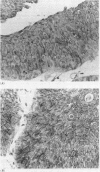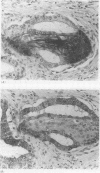Abstract
AIMS: To investigate the localisation of the E48 epitope and to determine the use of monoclonal antibody E48 for the identification of transitional cell carcinomas (TCC); and to determine if antigenic expression was affected by different standard fixation methods. METHODS: Biopsy specimens were labelled with E48 for immunoelectron microscopy. One hundred and nineteen tissue samples from 47 bladder carcinomas were tested for reactivity with E48, using fresh frozen, sublimate formalin, and formalin fixed tissue. Thirteen undifferentiated bladder tumours and 10 undifferentiated prostatic carcinomas were incubated with E48 and prostate specific antigen. RESULTS: Reactivity to E48 was found in all grade 1 and 2 carcinomas and most (83%) grade 3 tumours. At the ultrastructural level, expression was mainly associated with desmosomes and the cytoplasmic membrane. The reactivity of E48 was generally strong in fresh frozen tissue samples and remained preserved in fixed tissue samples. Ten of the 13 bladder carcinomas expressed E48; all prostatic tumours were totally negative. CONCLUSIONS: E48 is a sensitive marker for transitional cell carcinoma and suitable for differentiation between urothelial and prostatic undifferentiated carcinoma. It can be used in routinely processed, formalin fixed, biopsy specimens.
Full text
PDF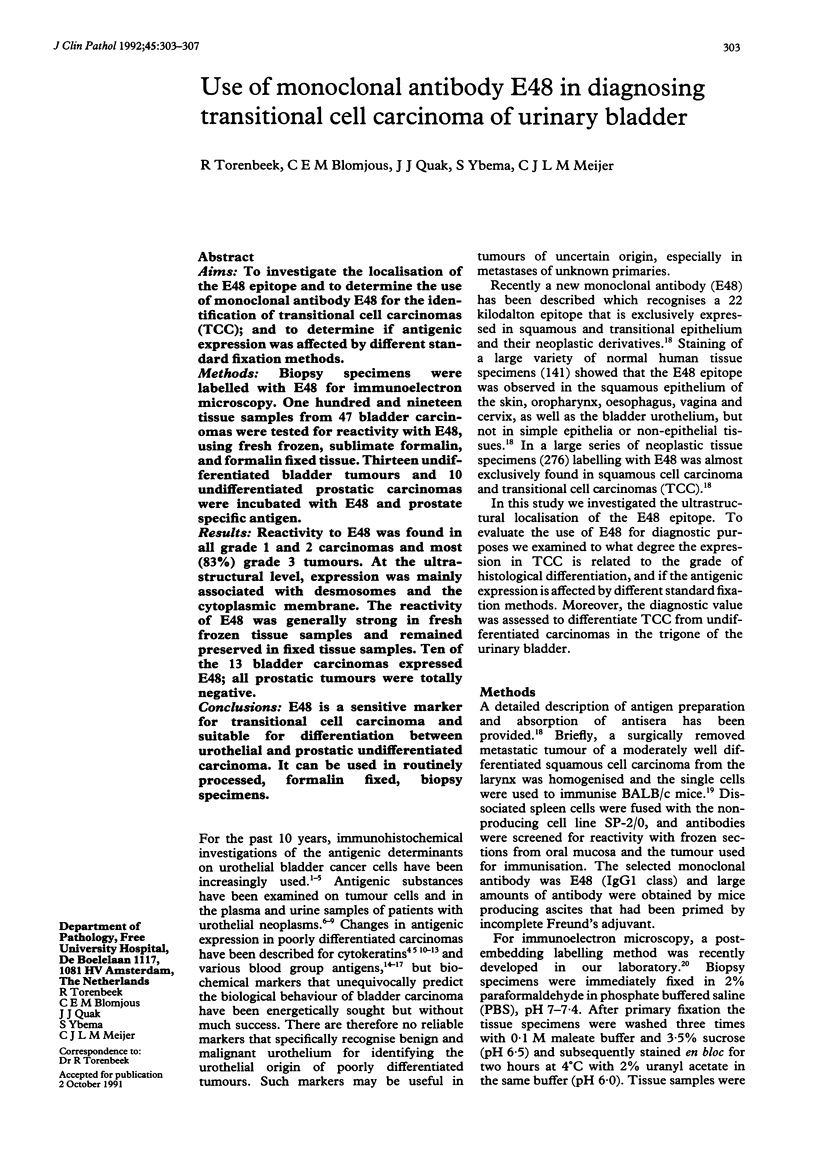
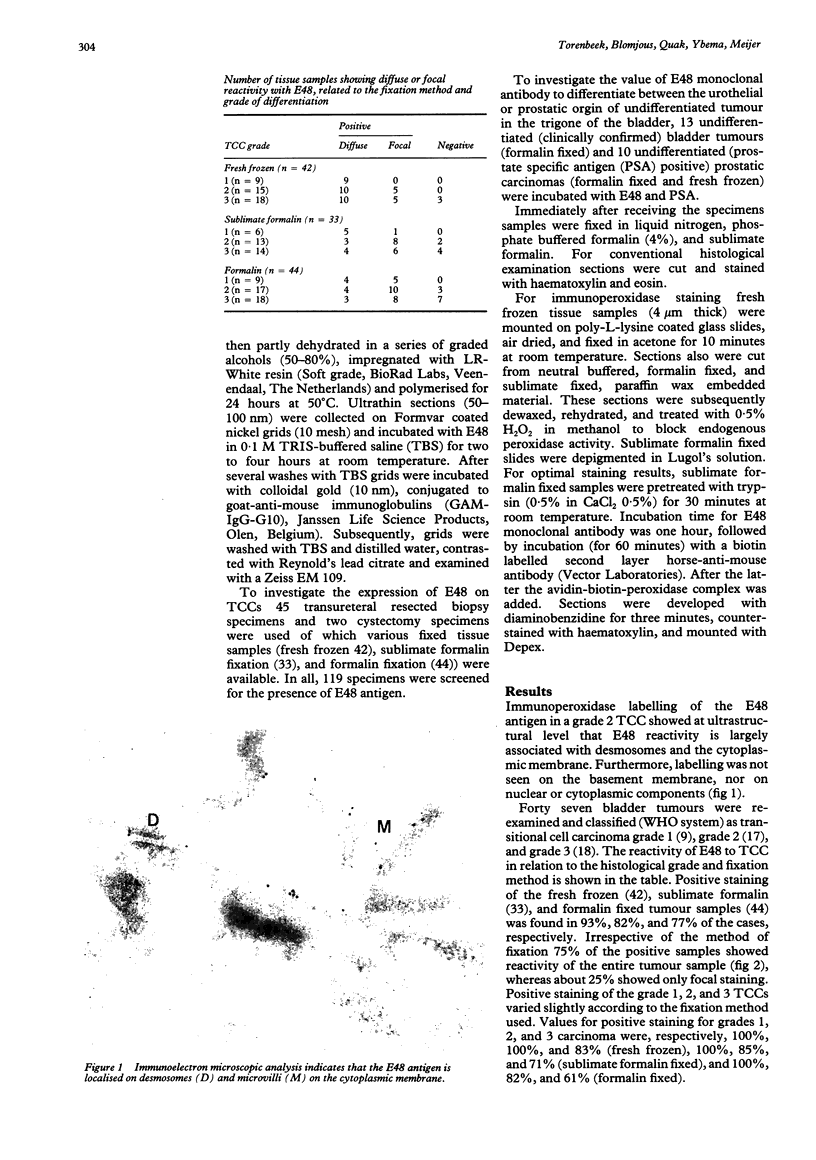
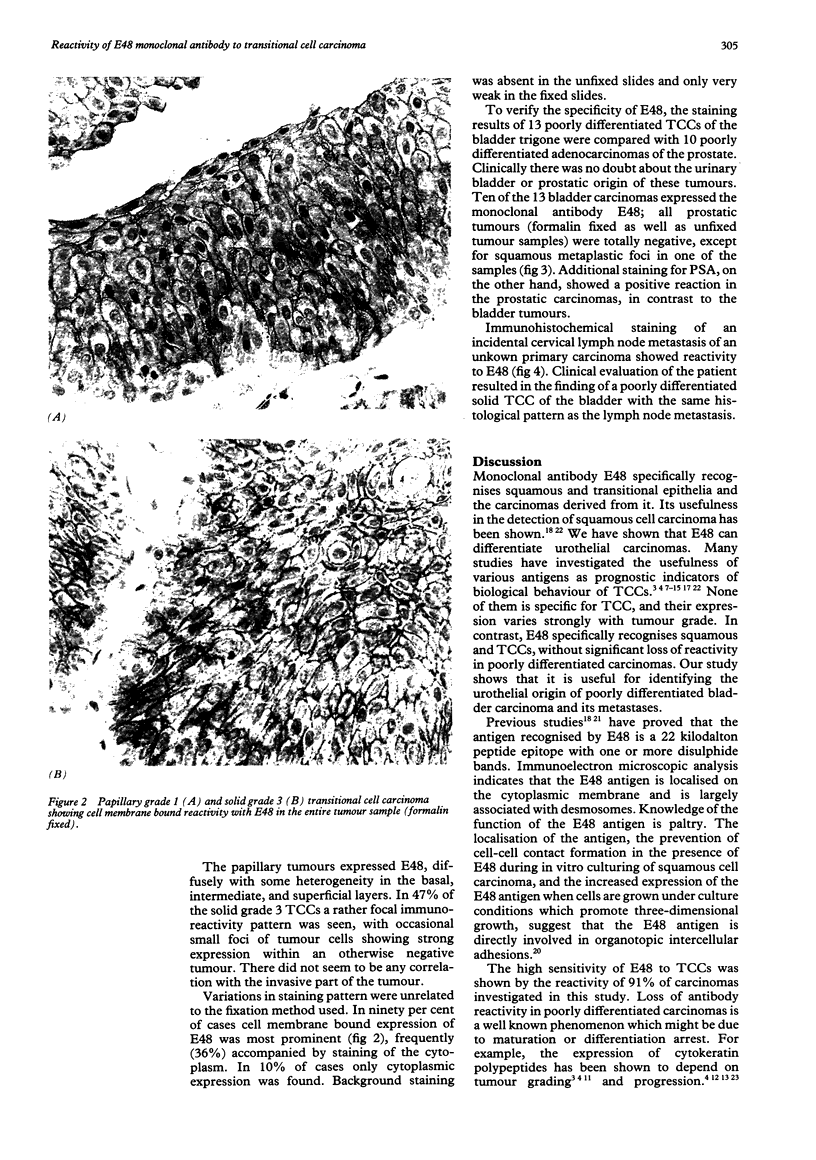
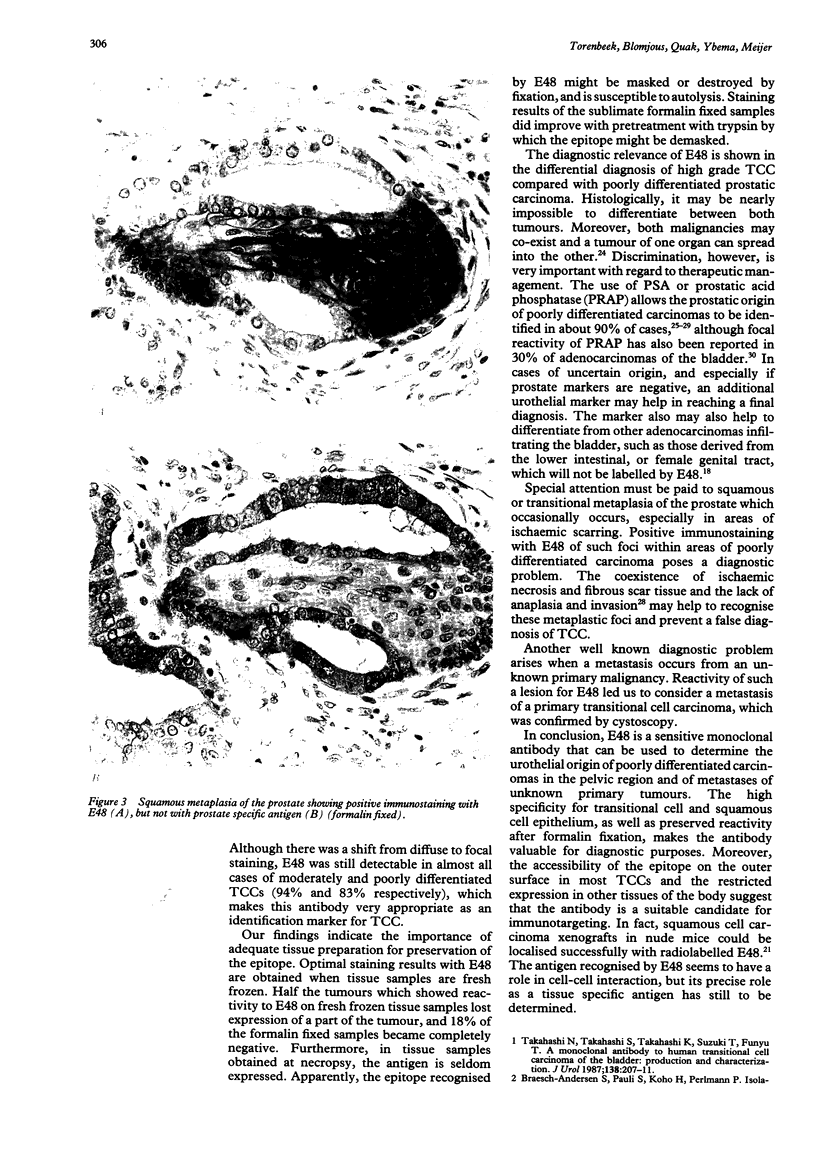
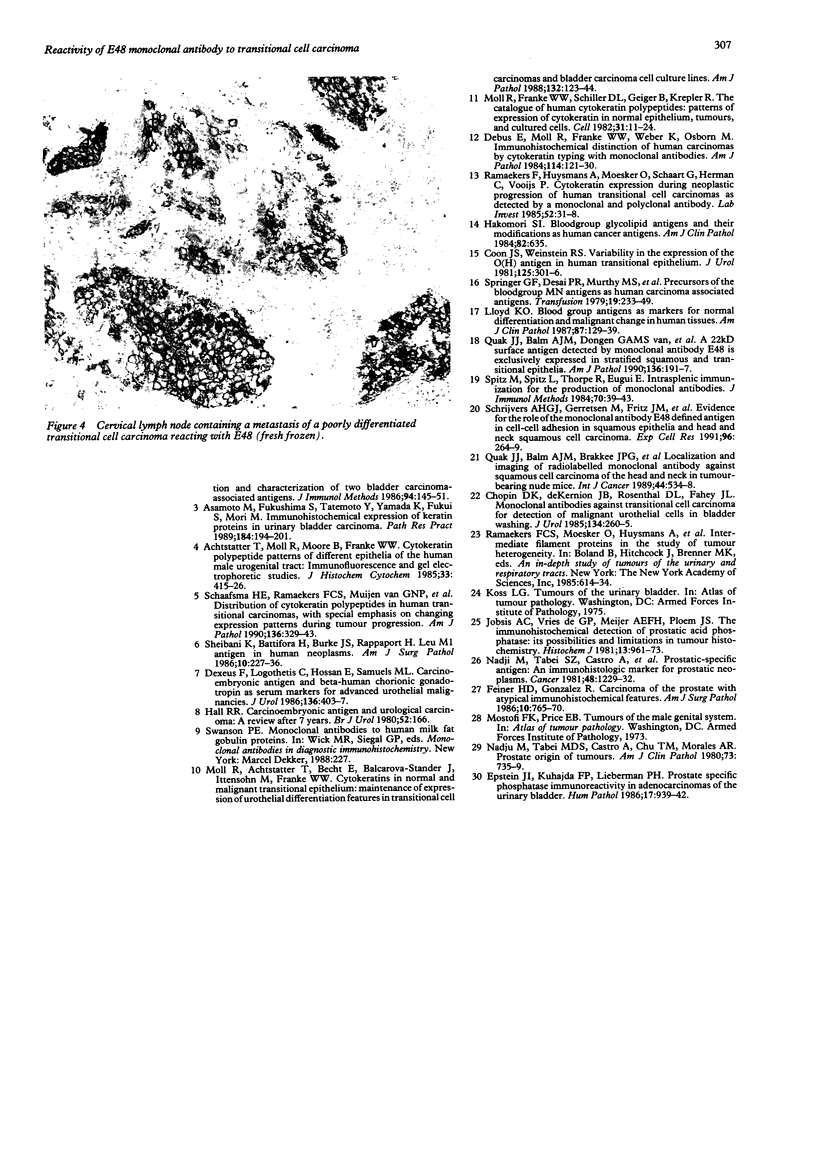
Images in this article
Selected References
These references are in PubMed. This may not be the complete list of references from this article.
- Asamoto M., Fukushima S., Tatemoto Y., Yamada K., Fukui S., Mori M. Immunohistochemical expression of keratin proteins in urinary bladder carcinoma. Pathol Res Pract. 1989 Feb;184(2):194–201. doi: 10.1016/S0344-0338(89)80120-7. [DOI] [PubMed] [Google Scholar]
- Chopin D. K., deKernion J. B., Rosenthal D. L., Fahey J. L. Monoclonal antibodies against transitional cell carcinoma for detection of malignant urothelial cells in bladder washing. J Urol. 1985 Aug;134(2):260–265. doi: 10.1016/s0022-5347(17)47118-7. [DOI] [PubMed] [Google Scholar]
- Coon J. S., Weinstein R. S. Variability in the expression of the O(H) antigen in human transitional epithelium. J Urol. 1981 Mar;125(3):301–306. doi: 10.1016/s0022-5347(17)55016-8. [DOI] [PubMed] [Google Scholar]
- Debus E., Moll R., Franke W. W., Weber K., Osborn M. Immunohistochemical distinction of human carcinomas by cytokeratin typing with monoclonal antibodies. Am J Pathol. 1984 Jan;114(1):121–130. [PMC free article] [PubMed] [Google Scholar]
- Dexeus F., Logothetis C., Hossan E., Samuels M. L. Carcinoembryonic antigen and beta-human chorionic gonadotropin as serum markers for advanced urothelial malignancies. J Urol. 1986 Aug;136(2):403–407. doi: 10.1016/s0022-5347(17)44882-8. [DOI] [PubMed] [Google Scholar]
- Epstein J. I., Kuhajda F. P., Lieberman P. H. Prostate-specific acid phosphatase immunoreactivity in adenocarcinomas of the urinary bladder. Hum Pathol. 1986 Sep;17(9):939–942. doi: 10.1016/s0046-8177(86)80645-1. [DOI] [PubMed] [Google Scholar]
- Feiner H. D., Gonzalez R. Carcinoma of the prostate with atypical immunohistological features. Clinical and histologic correlates. Am J Surg Pathol. 1986 Nov;10(11):765–770. doi: 10.1097/00000478-198611000-00003. [DOI] [PubMed] [Google Scholar]
- Hakomori S. Philip Levine award lecture: blood group glycolipid antigens and their modifications as human cancer antigens. Am J Clin Pathol. 1984 Dec;82(6):635–648. doi: 10.1093/ajcp/82.6.635. [DOI] [PubMed] [Google Scholar]
- Jöbsis A. C., De Vries G. P., Meijer A. E., Ploem J. S. The immunohistochemical detection of prostatic acid phosphatase: its possibilities and limitations in tumour histochemistry. Histochem J. 1981 Nov;13(6):961–973. doi: 10.1007/BF01002636. [DOI] [PubMed] [Google Scholar]
- Lloyd K. O. Philip Levine award lecture. Blood group antigens as markers for normal differentiation and malignant change in human tissues. Am J Clin Pathol. 1987 Jan;87(1):129–139. doi: 10.1093/ajcp/87.1.129. [DOI] [PubMed] [Google Scholar]
- Moll R., Achtstätter T., Becht E., Balcarova-Ständer J., Ittensohn M., Franke W. W. Cytokeratins in normal and malignant transitional epithelium. Maintenance of expression of urothelial differentiation features in transitional cell carcinomas and bladder carcinoma cell culture lines. Am J Pathol. 1988 Jul;132(1):123–144. [PMC free article] [PubMed] [Google Scholar]
- Moll R., Achtstätter T., Becht E., Balcarova-Ständer J., Ittensohn M., Franke W. W. Cytokeratins in normal and malignant transitional epithelium. Maintenance of expression of urothelial differentiation features in transitional cell carcinomas and bladder carcinoma cell culture lines. Am J Pathol. 1988 Jul;132(1):123–144. [PMC free article] [PubMed] [Google Scholar]
- Moll R., Franke W. W., Schiller D. L., Geiger B., Krepler R. The catalog of human cytokeratins: patterns of expression in normal epithelia, tumors and cultured cells. Cell. 1982 Nov;31(1):11–24. doi: 10.1016/0092-8674(82)90400-7. [DOI] [PubMed] [Google Scholar]
- Nadji M., Tabei S. Z., Castro A., Chu T. M., Morales A. R. Prostatic origin of tumors. An immunohistochemical study. Am J Clin Pathol. 1980 Jun;73(6):735–739. doi: 10.1093/ajcp/73.6.735. [DOI] [PubMed] [Google Scholar]
- Nadji M., Tabei S. Z., Castro A., Chu T. M., Murphy G. P., Wang M. C., Morales A. R. Prostatic-specific antigen: an immunohistologic marker for prostatic neoplasms. Cancer. 1981 Sep 1;48(5):1229–1232. doi: 10.1002/1097-0142(19810901)48:5<1229::aid-cncr2820480529>3.0.co;2-l. [DOI] [PubMed] [Google Scholar]
- Quak J. J., Balm A. J., Brakkee J. G., Scheper R. J., Haisma H. J., Braakhuis B. J., Meijer C. J., Snow G. B. Localization and imaging of radiolabelled monoclonal antibody against squamous-cell carcinoma of the head and neck in tumor-bearing nude mice. Int J Cancer. 1989 Sep 15;44(3):534–538. doi: 10.1002/ijc.2910440327. [DOI] [PubMed] [Google Scholar]
- Quak J. J., Balm A. J., van Dongen G. A., Brakkee J. G., Scheper R. J., Snow G. B., Meijer C. J. A 22-kd surface antigen detected by monoclonal antibody E 48 is exclusively expressed in stratified squamous and transitional epithelia. Am J Pathol. 1990 Jan;136(1):191–197. [PMC free article] [PubMed] [Google Scholar]
- Ramaekers F., Huysmans A., Moesker O., Schaart G., Herman C., Vooijs P. Cytokeratin expression during neoplastic progression of human transitional cell carcinomas as detected by a monoclonal and a polyclonal antibody. Lab Invest. 1985 Jan;52(1):31–38. [PubMed] [Google Scholar]
- Schrijvers A. H., Gerretsen M., Fritz J. M., van Walsum M., Quak J. J., Snow G. B., van Dongen G. A. Evidence for a role of the monoclonal antibody E48 defined antigen in cell-cell adhesion in squamous epithelia and head and neck squamous cell carcinoma. Exp Cell Res. 1991 Oct;196(2):264–269. doi: 10.1016/0014-4827(91)90260-2. [DOI] [PubMed] [Google Scholar]
- Sheibani K., Battifora H., Burke J. S., Rappaport H. Leu-M1 antigen in human neoplasms. An immunohistologic study of 400 cases. Am J Surg Pathol. 1986 Apr;10(4):227–236. doi: 10.1097/00000478-198604000-00001. [DOI] [PubMed] [Google Scholar]
- Spitz M., Spitz L., Thorpe R., Eugui E. Intrasplenic primary immunization for the production of monoclonal antibodies. J Immunol Methods. 1984 May 11;70(1):39–43. doi: 10.1016/0022-1759(84)90387-9. [DOI] [PubMed] [Google Scholar]
- Springer G. F., Desai P. R., Murthy M. S., Yang H. J., Scanlon E. F. Precursors of the blood group MN antigens as human carcinoma-associated antigens. Transfusion. 1979 May-Jun;19(3):233–249. doi: 10.1046/j.1537-2995.1979.19379204204.x. [DOI] [PubMed] [Google Scholar]
- Takahashi N., Takahashi S., Takahashi K., Suzuki T., Funyu T. A monoclonal antibody to human transitional cell carcinoma of the bladder: production and characterization. J Urol. 1987 Jul;138(1):207–211. doi: 10.1016/s0022-5347(17)43046-1. [DOI] [PubMed] [Google Scholar]




